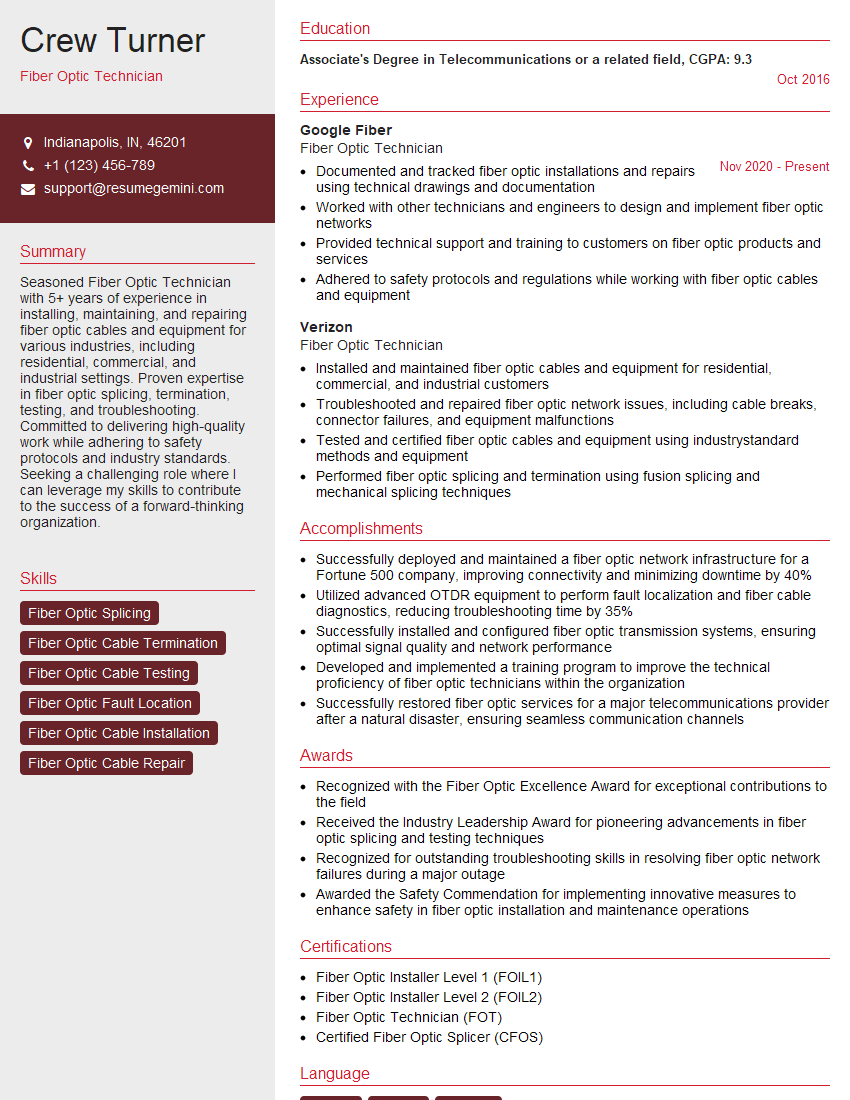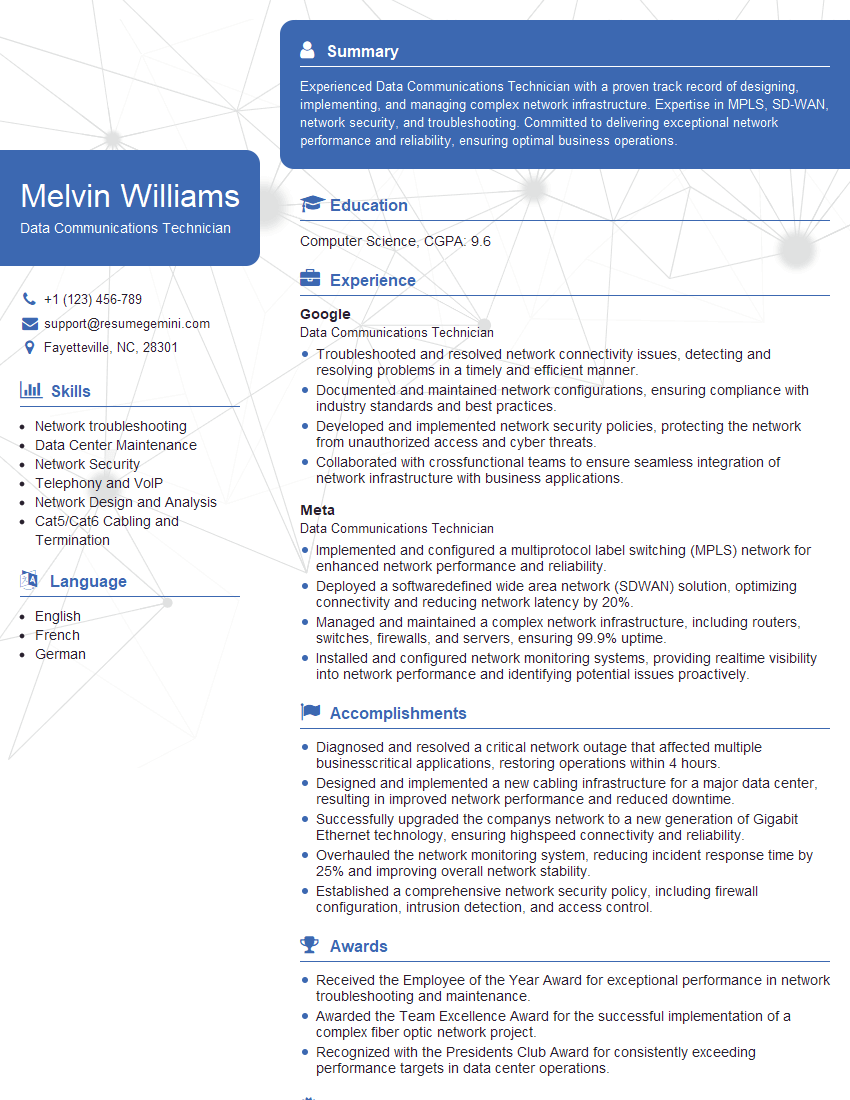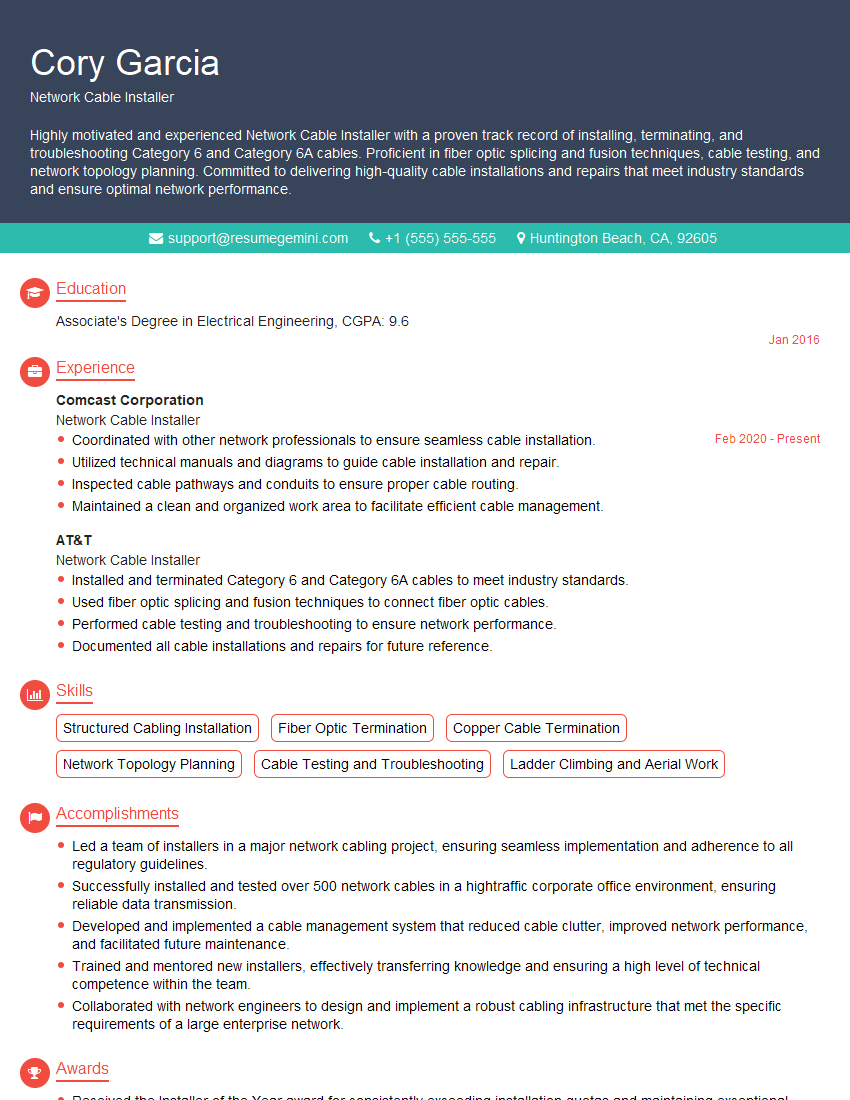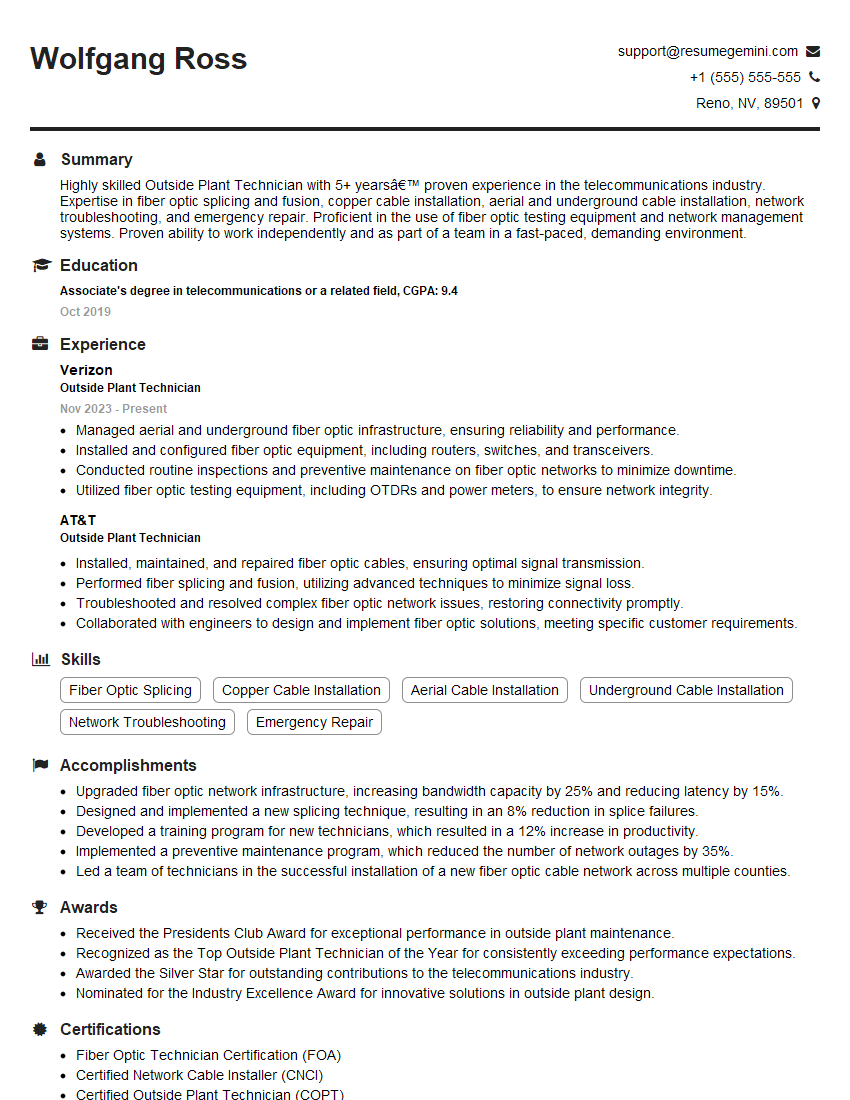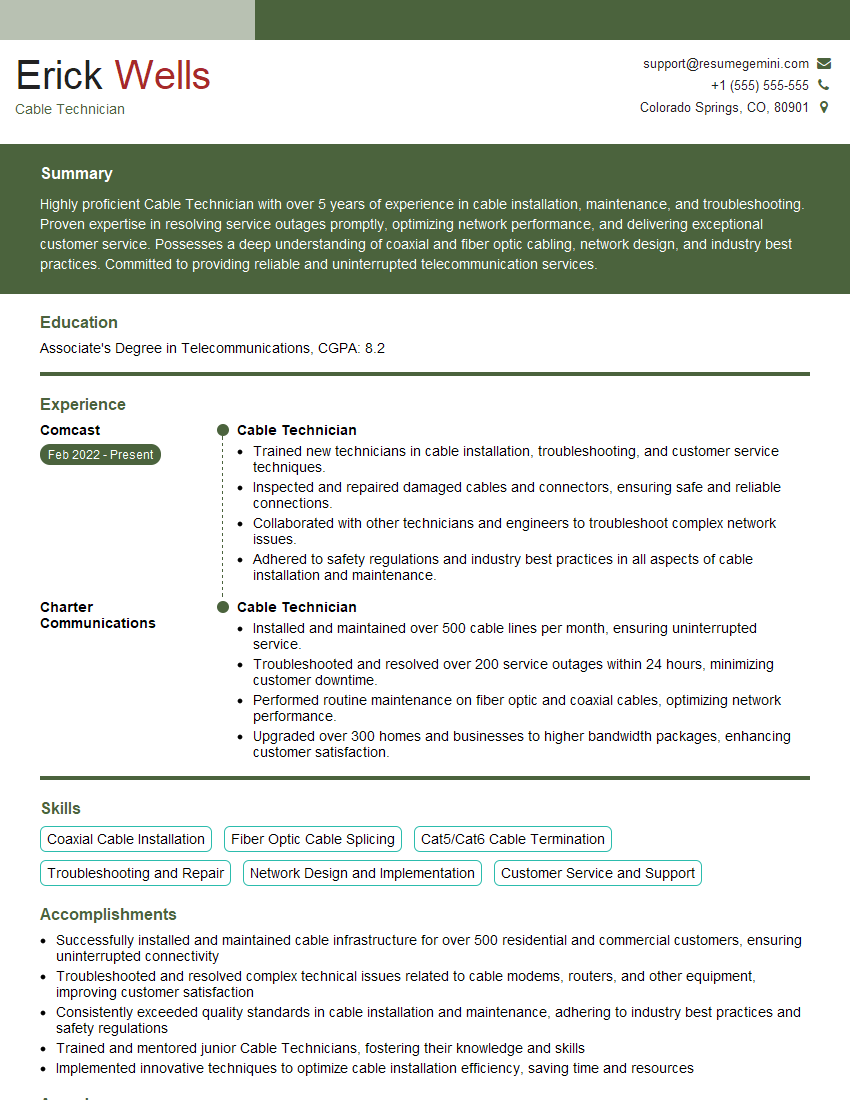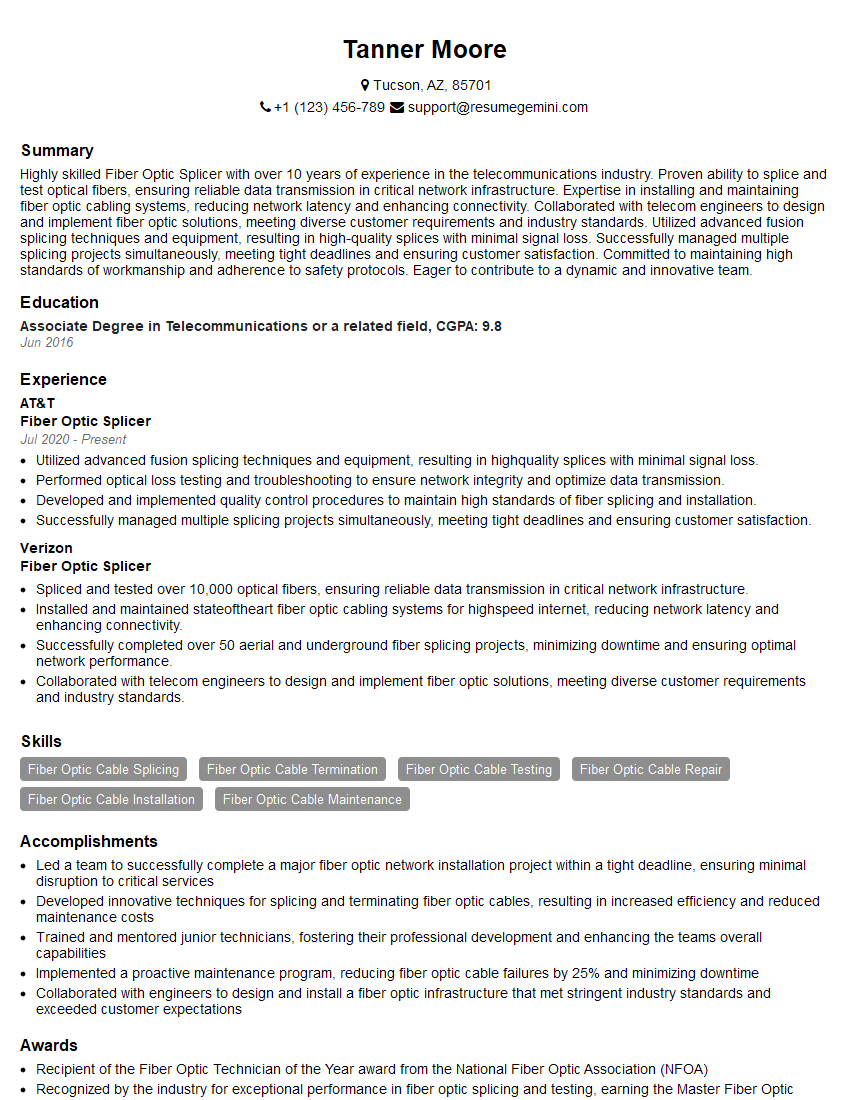The thought of an interview can be nerve-wracking, but the right preparation can make all the difference. Explore this comprehensive guide to Data Cable Splicing interview questions and gain the confidence you need to showcase your abilities and secure the role.
Questions Asked in Data Cable Splicing Interview
Q 1. Explain the difference between fusion splicing and mechanical splicing.
Fusion splicing and mechanical splicing are two primary methods for joining fiber optic cables. The key difference lies in how the fibers are joined. Fusion splicing uses heat and pressure to permanently fuse the fiber ends together, creating a virtually seamless connection. Think of it like welding two pieces of metal; the fibers become one. Mechanical splicing, on the other hand, uses a precisely aligned sleeve or connector to physically hold the fiber ends together. It’s more like using a strong adhesive to join two pieces of wood; the fibers remain separate but are securely aligned within the splice.
Fusion splicing offers superior performance with lower loss and higher reliability, but requires specialized equipment and expertise. Mechanical splicing is faster and less expensive, making it suitable for certain applications where the slightly higher signal loss is acceptable. The choice depends on the specific project requirements, budget, and the desired performance level.
Q 2. Describe the process of preparing fiber optic cable for splicing.
Preparing fiber optic cable for splicing is a meticulous process crucial for a successful and low-loss connection. The steps usually involve:
- Cable Cleaning: Thoroughly clean the fiber ends using isopropyl alcohol and lint-free wipes. Even a tiny speck of dust can severely impact the splice quality. Imagine trying to weld two pieces of metal with dirt between them – it wouldn’t work!
- Fiber Cutting: Use a precision cleaver to create a perfectly perpendicular cleave across the fiber end. An angled or rough cut introduces significant light scattering, increasing signal loss. Think of it like trying to connect two pipes – a clean cut ensures a perfect seal.
- Fiber Inspection: Use a microscope to examine the cleaved fiber end for any imperfections such as chips or scratches. Even microscopic flaws can impact signal transmission quality. A visual inspection ensures the connection starts clean and reliable.
- Stripping and Cleaning (for mechanical splicing): Carefully strip the protective coating from the fiber using a specialized stripping tool to expose only the required amount of fiber for the connector or sleeve in a mechanical splice. This precision prevents unnecessary damage to the fragile fiber.
These steps guarantee a flawless connection, minimizing signal loss and ensuring optimal performance.
Q 3. What safety precautions are necessary when working with fiber optic cables?
Safety is paramount when working with fiber optic cables. Although fiber optic cables don’t carry high voltage electricity like copper cables, they pose other hazards:
- Eye Safety: Direct exposure to intense laser light during fusion splicing can cause severe eye damage. Always wear appropriate laser safety eyewear rated for the specific wavelength of the laser source.
- Sharp Objects: Fiber cleavers and stripping tools have sharp edges that can cause cuts. Always handle these tools carefully and wear appropriate gloves.
- Fiber Dust: Small fiber fragments can cause irritation to the eyes, skin, and respiratory system. Always work in a well-ventilated area and wear a dust mask or respirator.
- Working at Heights: Often, splicing occurs in aerial locations. Use proper fall protection and safety harnesses if working at height.
Following these safety protocols minimizes risks and ensures a safe working environment.
Q 4. How do you test a fiber optic splice for proper continuity?
Testing a fiber optic splice involves using an Optical Time-Domain Reflectometer (OTDR) to measure the optical signal loss and identify any reflections or faults in the fiber. The OTDR sends a light pulse down the fiber and measures the amount of light that is reflected back. A good splice will have a low reflection and minimal insertion loss (signal loss when the light passes through the splice).
Other testing methods, like an Optical Power Meter, can be used to verify light levels before and after the splice for end-to-end verification. If there’s an unexpected significant loss or reflection, this indicates a problem that needs attention. It’s like checking the water flow in a pipe; a significant drop indicates a blockage.
Q 5. What are the common causes of fiber optic cable damage?
Fiber optic cables, while robust, are susceptible to damage from various sources:
- Physical Bending and Crushing: Excessive bending or crushing can cause micro-bending in the fiber, increasing signal attenuation and possibly causing fiber breakage. Imagine bending a drinking straw repeatedly until it cracks.
- Environmental Factors: Exposure to extreme temperatures, moisture, or chemicals can degrade the fiber and its protective coatings.
- Rodents: Rodents are known to chew on fiber optic cables causing complete breaks.
- Improper Installation: Incorrect handling or installation practices during deployment can lead to various types of damage, including excessive bending stress and fiber breakage.
- Construction Activities: Excavation or heavy machinery operating near buried fiber cables can result in significant physical damage.
Understanding these vulnerabilities allows for proactive measures such as proper cable routing, trenching, and protection from environmental elements.
Q 6. Explain the different types of connectors used in data cable splicing.
Several types of connectors are used in data cable splicing, each with specific characteristics and applications:
- SC (Subscriber Connector): A common connector known for its simple push-pull mechanism and reliability.
- LC (Lucent Connector): A smaller and more compact connector, preferred in high-density applications where space is limited.
- FC (Ferrule Connector): A precise connector with a threaded coupling, often used in applications requiring high precision and repeatability.
- ST (Straight Tip): An older style connector that is less common now but still found in legacy systems.
The choice of connector depends on factors such as budget, required performance, space constraints, and compatibility with existing infrastructure. Each connector type has its advantages and disadvantages in terms of cost, ease of use, and performance.
Q 7. How do you troubleshoot a faulty data cable connection?
Troubleshooting a faulty data cable connection follows a systematic approach:
- Visual Inspection: Begin by visually inspecting the cables and connectors for any physical damage, loose connections, or broken fibers.
- Connectivity Testing: Use an OTDR to test for signal attenuation or reflections in the fiber. This identifies the location of the fault along the cable.
- Connector Integrity: Examine the connectors for proper insertion and cleanliness. Clean the connector ends with isopropyl alcohol if necessary.
- Splice Inspection (If applicable): Verify the quality of any fiber splices using an OTDR.
- Equipment Checks: Check the functionality of the transmitting and receiving equipment. A fault might be within a component instead of the fiber connection.
This step-by-step process helps pinpoint the exact source of the problem for quick resolution. Think of it as diagnosing a car problem; you start with the obvious and gradually move to the more complex issues.
Q 8. What are the different types of cable sheath materials and their properties?
Cable sheath materials are crucial for protecting the inner conductors from environmental damage and ensuring signal integrity. The choice depends on the application’s demands – resistance to water, chemicals, abrasion, and temperature extremes.
- Polyethylene (PE): A common, cost-effective material offering good dielectric strength and flexibility. It’s suitable for many applications but can be susceptible to UV degradation and abrasion.
- High-Density Polyethylene (HDPE): A tougher, more durable version of PE with improved resistance to abrasion and chemicals. Often used in underground applications.
- Polyvinyl Chloride (PVC): Provides excellent resistance to chemicals and moisture, making it suitable for harsh environments. However, it’s less flexible than PE and can become brittle with age.
- Hypalon (Chlorosulfonated Polyethylene): A highly resistant material offering excellent protection against ozone, UV radiation, and chemicals. It’s ideal for outdoor and high-stress applications, but more expensive.
- Metal Sheaths (Aluminum, Steel): Offer superior mechanical protection against damage from crushing or rodents. Often used in high-risk areas but add weight and can be more prone to corrosion.
For example, in a submarine cable installation, you’d likely select a highly durable, corrosion-resistant sheath like Hypalon, or a steel sheath with additional corrosion protection. In a less demanding indoor setting, PVC or PE might suffice.
Q 9. Describe the process of identifying and labeling different cable types.
Accurate identification and labeling of cables is paramount for efficient troubleshooting and maintenance. This typically involves checking for markings on the cable jacket itself, and sometimes using cable identification tools.
Manufacturers often print identifying information directly onto the cable sheath, including:
- Cable type: (e.g., fiber optic, copper twisted pair, coaxial)
- Gauge/diameter: Indicates the conductor size.
- Manufacturer: Helps with warranty and support.
- Date of manufacture/batch number: For traceability and quality control.
If the cable jacket markings are unclear or damaged, specialized tools like cable identifiers can be used. These tools send a signal through the cable, and then identify the signal based on the manufacturer’s details. Sometimes, a color-coding system is also used; however, reliance on color coding alone can be risky as colors can fade over time.
Clear, consistent labeling at both ends and at splicing points using numbered tags with details like cable type, date of splicing, and the technician’s initials is essential.
Q 10. How do you handle different cable sizes and types during installation?
Handling different cable sizes and types requires careful planning and the right tools. Larger cables require more physical effort, specialized pulling equipment, and often require pre-planning of cable routes. It’s important to avoid over-bending or crushing, which can damage the conductors and reduce signal quality.
Strategies for handling diverse cable sizes include:
- Proper cable handling techniques: Use cable rollers and slings to minimize strain and prevent kinks.
- Appropriate pulling equipment: Choose winches, pullers, and lubricants suitable for different cable sizes and materials.
- Pre-planning of cable routes: Ensure sufficient space and access points for large-diameter cables, avoiding sharp bends or obstructions.
- Specialized tools: Use cable cutters, strippers, and connectors designed for different cable types and sizes.
For example, installing a large-diameter fiber optic cable in a conduit requires a powerful cable puller, proper lubrication, and careful monitoring to prevent damage to the delicate fiber.
Q 11. What are the advantages and disadvantages of different splicing methods?
Various splicing methods exist, each with its own strengths and weaknesses. The optimal choice depends on the cable type, environment, and required performance.
- Mechanical Splices: These utilize compression or crimping connectors to join cable ends. They’re fast and relatively easy, but can be less reliable for high-bandwidth applications and susceptible to signal loss over time.
- Fusion Splicing (Fiber Optic): This precise method melts the ends of optical fibers together, creating a near-perfect connection with minimal signal loss. It requires specialized equipment and training, but provides superior performance and longevity. It’s vital for fiber optic communication.
- Heat-Shrink Splices: A heat-shrinkable sleeve is placed over the joined cable ends, creating a waterproof and durable seal. They are generally robust, but can be more time-consuming than mechanical splices.
Advantages and Disadvantages Summary:
| Method | Advantages | Disadvantages |
|---|---|---|
| Mechanical | Fast, easy, inexpensive | Potentially higher signal loss, less durable |
| Fusion | Lowest signal loss, very durable | Requires specialized equipment and training, more expensive |
| Heat-Shrink | Durable, waterproof | More time-consuming than mechanical |
Choosing the right method is crucial. For instance, a mechanical splice might be sufficient for low-bandwidth applications in a controlled environment, while fusion splicing is essential for high-bandwidth fiber optic links demanding high reliability.
Q 12. What tools and equipment are essential for data cable splicing?
The tools and equipment needed depend on the specific cable type and splicing method. However, a basic toolkit would include:
- Cable cutters/strippers: For cleanly cutting and removing the cable sheath and insulation.
- Crimping tools: For securing connectors onto the cable conductors (mechanical splices).
- Fusion splicer (for fiber optic): For precisely joining optical fibers.
- Heat gun/heat shrink tubing: For creating a waterproof seal around the splice (heat-shrink splices).
- Fiber optic cleaver (for fiber optic): To create a precise and clean end face on the optical fiber.
- Optical time-domain reflectometer (OTDR): For testing the quality of fiber optic splices and identifying faults.
- Multimeter: For verifying continuity and signal quality after splicing.
- Safety equipment: Safety glasses, gloves, and potentially protective clothing.
More specialized tools may be required for certain applications, such as specialized cable pullers for large installations or underground work.
Q 13. How do you maintain accurate records of splicing activities?
Maintaining accurate records of splicing activities is crucial for ongoing maintenance, troubleshooting, and future upgrades. A well-maintained record helps identify the location and characteristics of each splice, providing valuable information for quick repairs.
Effective record-keeping methods include:
- Splice location maps: Detailed maps showing the exact location of each splice, marked with identification numbers.
- Splice logs: Detailed records for each splice, including date, time, technician’s initials, cable type, splice method, and any relevant test results (signal strength, attenuation).
- Digital databases: Using software to store and manage splice information, allowing for easy searching and retrieval.
- Photographs: Taking pictures of completed splices can aid in future inspections and troubleshooting.
All records should be clearly labeled, easily accessible, and kept up to date. This ensures a seamless continuity of service in case of failures.
Q 14. Explain the importance of proper grounding and bonding in cable splicing.
Proper grounding and bonding are vital in data cable splicing for several reasons: protecting against electrical surges, ensuring signal integrity, and preventing safety hazards.
Grounding: Connecting the cable shield or metallic sheath to earth ground helps dissipate stray electrical currents, preventing damage to equipment and protecting personnel from electrical shock. This is particularly important for outdoor installations exposed to lightning strikes.
Bonding: Connecting metallic components within a cable system (e.g., different cable segments, conduit, grounding bars) ensures a low-impedance path for electrical currents, preventing voltage differentials that could lead to damage or signal interference. A good bond reduces the risk of ground loops.
Consequences of inadequate grounding and bonding:
- Signal noise and interference: Voltage differentials can cause signal distortion and reduced performance.
- Equipment damage: Electrical surges can fry sensitive electronic devices.
- Safety hazards: Electrical shock can be lethal.
Imagine a lightning strike hitting a metal conduit containing data cables. Without proper grounding, the surge could travel through the cables, damaging connected equipment and potentially endangering personnel. Proper grounding and bonding mitigates this risk significantly.
Q 15. How do you ensure the longevity and reliability of your splices?
Ensuring the longevity and reliability of data cable splices is paramount for maintaining a stable and high-performing network. It’s a multi-faceted approach focusing on meticulous technique, high-quality materials, and proper environmental protection.
- High-Quality Materials: Using fusion splicers with precise alignment capabilities and employing only high-quality splice protection sleeves and trays is crucial. Inferior materials can degrade faster, leading to signal loss and potential failure.
- Precise Splicing Technique: A clean splice with minimal loss is fundamental. This involves careful fiber preparation, precise fusion splicing, and thorough visual inspection. Even small imperfections can lead to significant attenuation over time.
- Environmental Protection: Splices need robust protection from moisture, temperature fluctuations, and physical damage. This means utilizing sealed splice closures, properly sealed trays, and strategic cable routing to avoid stress points. I once encountered a situation where a splice enclosure wasn’t properly sealed, leading to water ingress and significant attenuation within a month. Proper sealing prevented this in other projects.
- Regular Testing and Maintenance: Post-installation testing and periodic optical time-domain reflectometry (OTDR) testing allow early detection of potential issues. This proactive approach prevents catastrophic failures and allows for timely repairs.
Career Expert Tips:
- Ace those interviews! Prepare effectively by reviewing the Top 50 Most Common Interview Questions on ResumeGemini.
- Navigate your job search with confidence! Explore a wide range of Career Tips on ResumeGemini. Learn about common challenges and recommendations to overcome them.
- Craft the perfect resume! Master the Art of Resume Writing with ResumeGemini’s guide. Showcase your unique qualifications and achievements effectively.
- Don’t miss out on holiday savings! Build your dream resume with ResumeGemini’s ATS optimized templates.
Q 16. What are some common problems you’ve encountered during splicing and how did you resolve them?
Common problems I’ve encountered include fiber breakage during stripping or cleaving, improper fusion splicing resulting in high loss, and issues with connector termination leading to poor connection stability.
- Fiber Breakage: This often stems from using dull cleavers or applying excessive force during stripping. The solution involves regularly replacing cleaving blades, using appropriate stripping tools, and practicing precise techniques. Proper fiber handling is key – think of it like working with delicate strands of glass.
- Improper Fusion Splicing: This can result from misalignment during the fusion process or insufficient heat application. Using a high-quality fusion splicer with precise alignment aids, and paying close attention to the splice parameters and visual inspection after splicing, are essential. I’ve used advanced splicers that offer real-time loss readings and image analysis, dramatically reducing this issue.
- Connector Termination Issues: This can include loose connectors, scratches on the fiber end face or improper epoxy curing. Careful connector polishing and a methodical approach to epoxy application and curing are vital. Double-checking the connector’s physical connection before finalizing and testing it prevents many issues.
Q 17. How do you interpret splicing specifications and blueprints?
Splicing specifications and blueprints provide critical information for successful splicing operations. They detail cable type, fiber count, splice location, required splice loss, and specific connector types.
Interpreting these documents involves careful review of:
- Cable Type and Fiber Characteristics: Identifying the type of fiber (single-mode, multi-mode) and its core diameter is vital for selecting appropriate tools and techniques.
- Splice Location and Routing: The blueprint shows the exact locations of splices, cable routes, and the placement of splice enclosures, influencing cable management and protection strategies.
- Splice Loss Budget: Specifications outline the acceptable splice loss per splice and the overall budget for the entire network. This guides the choice of splicing techniques and quality control measures. Exceeding the loss budget necessitates further investigation and corrective action.
- Connector Types and Specifications: The document specifies which connectors to use (SC, FC, LC, etc.), their orientation and polarity, which impacts compatibility and future maintenance.
For example, a blueprint might specify a maximum splice loss of 0.3dB per splice for a single-mode fiber network. This informs my approach to the splicing process, ensuring that each splice meets or falls below this target.
Q 18. What are the different types of cable faults and their troubleshooting methods?
Cable faults vary but some of the most common include attenuation (signal loss), breaks, macrobends, and connector issues. Troubleshooting methods depend on the type of fault.
- Attenuation: High attenuation can stem from poor splices, dirty connectors, or fiber damage. OTDR testing precisely locates and quantifies the attenuation, often pinpointing the problem area. Cleaning connectors or repairing or replacing faulty splices resolves this.
- Breaks: Fiber breaks cause complete signal loss. OTDR testing easily identifies the break location; then, careful excavation and splicing are needed for repair. In some cases, it may be more efficient to replace a section of cable.
- Macrobends: Sharp bends in the cable cause increased attenuation. Correcting the cable routing by carefully bending the cable and removing stress points, resolving the macrobend and restoring signal quality.
- Connector Issues: Dirty or loose connectors are common problems, causing intermittent or complete signal loss. Cleaning connectors with appropriate cleaning solutions and ensuring secure physical connections usually resolve this.
A systematic approach is crucial – starting with visual inspection, followed by OTDR testing, and finally, targeted troubleshooting based on the test results.
Q 19. Explain the importance of proper fiber cleaving.
Proper fiber cleaving is absolutely crucial for achieving low-loss fiber optic splices. A poorly cleaved fiber end face introduces irregularities and imperfections that increase light scattering and reflection, leading to signal loss and potentially unstable connections.
A clean, perpendicular cleave creates a smooth, flat surface, essential for maximizing optical power transmission during splicing. Using a high-quality cleaver, ensuring the fiber is securely held, and practicing consistent technique are essential for consistent, high-quality cleaves. An imperfect cleave can result in several decibels of added loss. Think of it as trying to connect two perfectly polished lenses versus two chipped pieces of glass.
Q 20. Describe the process of installing a fiber optic splice enclosure.
Installing a fiber optic splice enclosure involves several steps, ensuring environmental protection and easy access for future maintenance.
- Site Preparation: Choose a suitable location, free from excessive moisture, temperature fluctuations, and potential physical damage. Prepare the area by clearing debris and ensuring a stable base for the enclosure.
- Enclosure Mounting: Securely mount the splice enclosure using appropriate hardware, ensuring a stable and secure installation. The mounting location should facilitate easy access.
- Cable Entry and Termination: Carefully feed the cables into the enclosure, ensuring proper strain relief to prevent damage. Prepare the fiber ends for splicing according to specifications.
- Splice Creation: Carry out the splicing process, ensuring low loss and optimal alignment using fusion splicing or mechanical splicing techniques, following appropriate protocols.
- Closure Sealing: After splicing, carefully seal the enclosure and connectors to protect the splices from environmental elements. This usually involves sealing the enclosure with a specialized sealant and ensuring all connectors have covers or protection.
- Testing and Documentation: After installation, conduct thorough testing using an OTDR to verify the splice loss and overall network integrity. Document all details, including splice location, loss values, and any other relevant information.
Q 21. How do you manage and handle different types of connectors (SC, FC, LC, etc.)?
Managing and handling different connector types (SC, FC, LC, etc.) requires attention to detail and awareness of their specific features. Each type has a unique design, with variations in size, latching mechanisms, and fiber alignment.
- Careful Handling: Connectors are delicate; avoid excessive force during installation or cleaning. Always use the appropriate connector cleaning tools and solutions.
- Polarity Awareness: Some connectors (like SC) have polarization sensitivity; incorrect orientation can lead to signal loss. Ensure correct alignment during termination and mating.
- Tool Selection: Utilize the right tools for each connector type. Using incompatible tools can damage the connector.
- Storage and Organization: Store connectors appropriately to prevent damage. Keep connectors organized and labeled for easy identification and retrieval.
For instance, an LC connector is smaller than an SC, requiring more precision during termination and connection. Using the wrong tool, or applying too much force, can easily damage the delicate latching mechanism or the fiber itself. Proper training and familiarity with each connector type are fundamental for efficient and reliable work.
Q 22. What is OTDR testing and how is it used in fiber optic splicing?
OTDR, or Optical Time Domain Reflectometer, testing is a crucial part of fiber optic splicing. Think of it as an ultrasound for fiber optic cables. It sends light pulses down the fiber and measures how much light is reflected back at different points. This reflection data reveals things like fiber breaks, splices, and bends, allowing us to pinpoint issues and assess the quality of the connection. In splicing, we use OTDR testing before splicing to assess the existing fiber’s health, after splicing to verify the quality of the splice itself (ensuring minimal loss), and to troubleshoot problems after the cable has been installed.
For example, a significant loss of signal at a specific point on the OTDR trace would indicate a poor splice requiring attention. A sudden drop to zero signal would point to a fiber break. By analyzing the OTDR trace, we can identify the exact location of these issues, enabling targeted repairs or re-splicing.
Q 23. How do you ensure proper cable termination?
Proper cable termination is vital for a reliable connection and signal integrity. It involves preparing the fiber end for connection, using appropriate connectors, and ensuring a clean, precise connection. The steps include:
- Cleaning: Thoroughly cleaning the fiber end with appropriate cleaning supplies (lint-free wipes and cleaning solutions) to remove any dust or debris. Even a tiny speck can significantly degrade the signal.
- Cleaving: Using a cleaver to create a perfectly perpendicular end face on the fiber. A poorly cleaved end will lead to significant signal loss.
- Connector Installation: Carefully fitting the chosen connector (e.g., SC, LC, ST) onto the prepared fiber end, ensuring proper alignment and secure adhesion using epoxy or other appropriate adhesives.
- Polishing (if needed): Polishing the connector to achieve the correct surface smoothness. This is crucial for low-loss connections.
- Testing: Verifying the termination quality using a power meter and optionally an OTDR to ensure minimal signal loss.
Imagine trying to connect two water pipes with rough, uneven ends – water would leak! Similarly, a poorly terminated fiber will result in signal loss and potential network failures.
Q 24. What are the best practices for storing and handling fiber optic cables?
Fiber optic cables are sensitive to environmental factors. Proper storage and handling are essential to prevent damage and maintain their performance. Best practices include:
- Storage Environment: Store cables in a cool, dry, and clean environment, away from direct sunlight, moisture, and extreme temperatures. Ideally, they should be stored on reels in a controlled climate environment.
- Handling Precautions: Avoid sharp bends, kinks, or excessive twisting. Use proper cable handling equipment when working with heavier cables or long spans.
- Protection from Damage: Protect cables from physical damage during transport and storage. Use protective coverings, cable trays, or conduits as needed.
- Labeling and Inventory: Maintain detailed inventory records and label cables clearly to ensure easy identification and tracking.
Think of them like delicate silk threads – improper handling can easily break them. Careful attention to detail is crucial for long-term performance.
Q 25. How do you perform a visual inspection of a fiber optic splice?
A visual inspection of a fiber optic splice is the first and often most important step in evaluating its quality. Using a microscope or a splice inspection tool (visual fault locator or VFL), you carefully examine the splice to identify any potential problems. We look for:
- Fiber Alignment: Ensure that the two fiber ends are precisely aligned in the splice, minimizing signal loss.
- Cleavage Quality: Check if the cleaved ends of both fibers are clean and perpendicular.
- Air Gaps or Debris: Identify any air gaps or debris within the splice, which can cause signal attenuation.
- Signs of Damage: Look for any signs of physical damage to the fibers or the splice itself.
A careful visual inspection can often identify issues that would be difficult or impossible to detect using only OTDR measurements, and it is always the first step in troubleshooting.
Q 26. Describe your experience with different types of cable (copper, fiber, coaxial).
My experience encompasses all three cable types: copper, fiber, and coaxial. Copper cables (like twisted-pair and coaxial) are prevalent in older and some current network infrastructure, carrying signals using electrical current. Copper is easier and less expensive to terminate, but suffers from higher signal attenuation and susceptibility to electromagnetic interference (EMI) compared to fiber. Coaxial cables are still commonly used in applications like cable television and some video surveillance systems.
Fiber optic cables transmit data using light pulses, providing much higher bandwidth, lower signal loss, and immunity to EMI, making them ideal for long-distance and high-speed data transmission. My experience with fiber splicing is extensive, covering various fiber types, connector types, and splicing techniques.
Q 27. What are the safety regulations related to working at heights during cable splicing?
Safety regulations related to working at heights during cable splicing are paramount. They usually involve adherence to OSHA (or equivalent local regulations) standards and often include:
- Fall Protection: Always use appropriate fall protection equipment, such as harnesses, lanyards, and anchor points.
- Proper Training: All personnel involved must receive adequate training in fall protection techniques and the use of safety equipment.
- Risk Assessment: A thorough risk assessment must be performed before commencing any work at height to identify and mitigate potential hazards.
- Safety Equipment Inspections: Regular inspection and maintenance of all safety equipment are essential.
- Emergency Procedures: Emergency procedures and communication protocols must be established and well understood by all team members.
Working at heights is inherently dangerous. Strict adherence to safety regulations is not just a best practice; it’s a necessity to prevent serious injuries or fatalities.
Q 28. Explain your understanding of network topology and its relevance to cable splicing.
Network topology refers to the physical or logical layout of a network. Understanding network topology is crucial in cable splicing because it dictates how cables are routed and connected. Common topologies include star, ring, bus, and mesh networks.
For example, in a star topology, all cables converge at a central point (e.g., a switch or router). Cable splicing in this scenario focuses on connecting individual cables to the central point. In a ring topology, cables form a closed loop, requiring careful splicing and testing to ensure signal continuity. A mesh topology, characterized by multiple redundant paths, requires even more complex splicing and routing strategies. Knowledge of the specific network topology guides the splicing process, ensuring efficient and reliable network connectivity.
Key Topics to Learn for Data Cable Splicing Interview
- Fiber Optic Cable Types and Properties: Understanding different fiber types (single-mode, multi-mode), their characteristics, and applications is crucial. Be prepared to discuss the advantages and disadvantages of each.
- Splicing Techniques: Mastering various splicing methods, including fusion splicing and mechanical splicing, is essential. Practice explaining the steps involved in each process and the tools used.
- Optical Loss and Measurement: Learn how to identify and measure optical loss in a fiber optic cable. Understand the causes of loss and methods for minimizing it. Familiarize yourself with OTDR testing.
- Cable Preparation and Termination: Thoroughly understand the proper techniques for preparing fiber optic cables for splicing or termination. This includes stripping, cleaning, and cleaving the fiber.
- Troubleshooting and Repair: Be prepared to discuss common problems encountered during splicing and how to troubleshoot and repair them. This includes dealing with broken fibers, poor connections, and high attenuation.
- Safety Procedures and Regulations: Demonstrate your knowledge of safety regulations and best practices for working with fiber optic cables and equipment. This includes understanding laser safety precautions.
- Network Topologies and Applications: Connect your splicing knowledge to broader network concepts. Understand how fiber optic cables are used in different network topologies and applications (e.g., FTTH, LANs, WANs).
Next Steps
Mastering data cable splicing opens doors to rewarding careers in telecommunications, networking, and data center infrastructure. Your expertise in this critical skill will make you a highly sought-after candidate. To significantly boost your job prospects, create a compelling and ATS-friendly resume that highlights your skills and experience. ResumeGemini is a trusted resource that can help you craft a professional and effective resume. They offer examples of resumes tailored specifically to Data Cable Splicing to help you get started. Invest time in building a strong resume – it’s your first impression to potential employers.
Explore more articles
Users Rating of Our Blogs
Share Your Experience
We value your feedback! Please rate our content and share your thoughts (optional).
What Readers Say About Our Blog
Hello,
We found issues with your domain’s email setup that may be sending your messages to spam or blocking them completely. InboxShield Mini shows you how to fix it in minutes — no tech skills required.
Scan your domain now for details: https://inboxshield-mini.com/
— Adam @ InboxShield Mini
Reply STOP to unsubscribe
Hi, are you owner of interviewgemini.com? What if I told you I could help you find extra time in your schedule, reconnect with leads you didn’t even realize you missed, and bring in more “I want to work with you” conversations, without increasing your ad spend or hiring a full-time employee?
All with a flexible, budget-friendly service that could easily pay for itself. Sounds good?
Would it be nice to jump on a quick 10-minute call so I can show you exactly how we make this work?
Best,
Hapei
Marketing Director
Hey, I know you’re the owner of interviewgemini.com. I’ll be quick.
Fundraising for your business is tough and time-consuming. We make it easier by guaranteeing two private investor meetings each month, for six months. No demos, no pitch events – just direct introductions to active investors matched to your startup.
If youR17;re raising, this could help you build real momentum. Want me to send more info?
Hi, I represent an SEO company that specialises in getting you AI citations and higher rankings on Google. I’d like to offer you a 100% free SEO audit for your website. Would you be interested?
Hi, I represent an SEO company that specialises in getting you AI citations and higher rankings on Google. I’d like to offer you a 100% free SEO audit for your website. Would you be interested?
good
